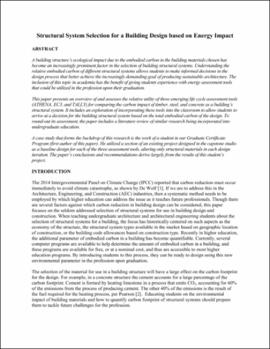| dc.contributor.author | Phillips, John J. | |
| dc.contributor.author | Spector, Tom Elliott | |
| dc.contributor.author | Mansy, Khaled | |
| dc.contributor.author | Homer, Jeanne M. | |
| dc.contributor.author | Crawford, William | |
| dc.coverage.spatial | Virtual Conference | |
| dc.date.accessioned | 2022-04-19T20:18:01Z | |
| dc.date.available | 2022-04-19T20:18:01Z | |
| dc.date.issued | 2021-07-26 | |
| dc.identifier | oksd_mansy_structuralsystemselection_2021 | |
| dc.identifier.citation | Phillips, J. J., Spector, T. E., Mansy, K., Homer, J. M., & Crawford, W. (2021). Structural system selection for a building design based on energy impact. Paper presented at the annual conference of the American Society for Engineering Education Annual Conference and Exposition [remote]. | |
| dc.identifier.uri | https://hdl.handle.net/11244/335255 | |
| dc.description.abstract | A building structure�s ecological impact due to the embodied carbon in the building materials chosen has become an increasingly prominent factor in the selection of building structural systems. Understanding the relative embodied carbon of different structural systems allows students to make informed decisions in the design process that better achieve the increasingly demanding goal of producing sustainable architecture. The inclusion of this topic in academia has the benefit of giving students experience with energy assessment tools that could be utilized in the profession upon their graduation. | |
| dc.description.abstract | This paper presents an overview of and assesses the relative utility of three emerging life cycle assessment tools (ATHENA, EC3, and TALLY) for comparing the carbon impact of timber, steel, and concrete as a building�s structural system. It includes an exploration of incorporating these tools into the classroom to allow students to arrive at a decision for the building structural system based on the total embodied carbon of the design. To round-out its assessment, the paper includes a literature review of similar research being incorporated into undergraduate education. | |
| dc.description.abstract | A case study that forms the backdrop of this research is the work of a student in our Graduate Certificate Program (first author of this paper). He utilized a section of an existing project designed in the capstone studio as a baseline design for each of the three assessment tools, altering only structural materials in each design iteration. The paper�s conclusions and recommendations derive largely from the results of this student�s project. | |
| dc.format | application/pdf | |
| dc.language | en_US | |
| dc.publisher | American Society for Engineering Education (ASEE) Conferences | |
| dc.relation.ispartof | ASEE Annual Conference and Exposition, Conference Proceedings | |
| dc.relation.uri | https://strategy.asee.org/37738 | |
| dc.rights | This material has been previously published. In the Oklahoma State University Library's institutional repository this version is made available through the open access principles and the terms of agreement/consent between the author(s) and the publisher. The permission policy on the use, reproduction or distribution of the material falls under fair use for educational, scholarship, and research purposes. Contact Digital Resources and Discovery Services at lib-dls@okstate.edu or 405-744-9161 for further information. | |
| dc.title | Structural system selection for a building design based on energy impact | |
| dc.date.updated | 2022-04-13T15:48:48Z | |
| osu.filename | oksd_mansy_structuralsystemselection_2021.pdf | |
| dc.description.department | Architecture | |
| dc.type.genre | Conference proceedings | |
| dc.type.material | Text | |
